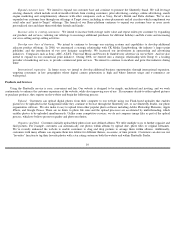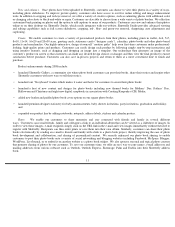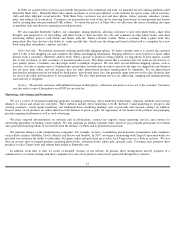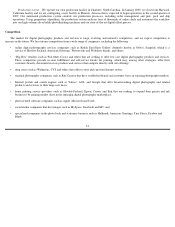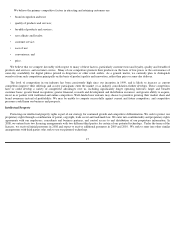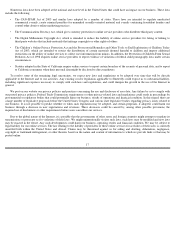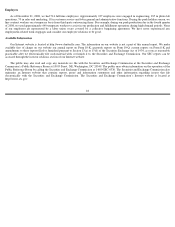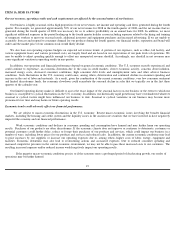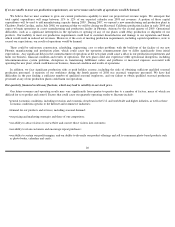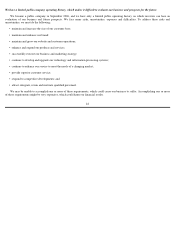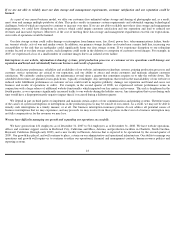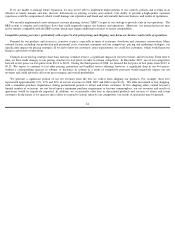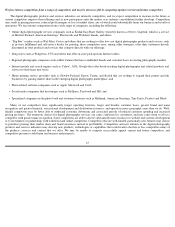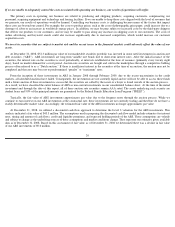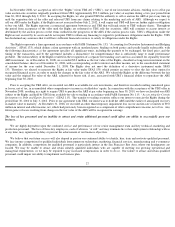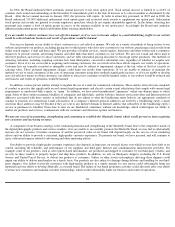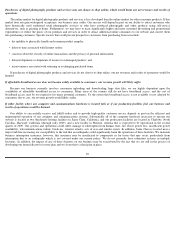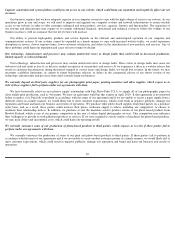Shutterfly 2009 Annual Report Download - page 22
Download and view the complete annual report
Please find page 22 of the 2009 Shutterfly annual report below. You can navigate through the pages in the report by either clicking on the pages listed below, or by using the keyword search tool below to find specific information within the annual report.
If we are unable to meet our production requirements, our net revenues and results of operations would be harmed.
We believe that we must continue to grow our current production capability to meet our projected net revenue targets. We anticipate that
total capital expenditures will range between 11% to 12% of our expected calendar year 2009 net revenues. A portion of those capital
expenditures will be used to add manufacturing capacity during 2009. During 2007, we opened a new manufacturing and production plant in
Charlotte, North Carolina, and in July 2008, we announced that we will be closing our Hayward, California production facility in early 2009 and
expect to begin operations in a new manufacturing and production facility in Phoenix, Arizona by the second quarter of 2009. Operational
difficulties, such as a significant interruption in the operation or opening of any of our plants could delay production or shipment of our
products. Our inability to meet our production requirements could lead to customer dissatisfaction and damage to our reputation and brand,
which would result in reduced net revenues. Moreover, if the costs of meeting production requirements, including capital expenditures, were to
exceed our expectations, our results of operations would be harmed.
There could be unforeseen construction, scheduling, engineering, cost or other problems with the build-
out of the facility of our new
Phoenix manufacturing and production plant, which could cause the operation commencement date to differ significantly from initial
expectations. Any significant delay in the commencement of operations at the new plant could cause a delay in our production requirements and
harm our business, financial condition and results of operations. The new plant could also experience other operational disruptions, including
telecommunications system problems, disruptions in transitioning fulfillment orders and problems or increased expenses associated with
operating the new plant, which could harm our business, financial condition and results of operations.
In addition, we face significant production risks at peak holiday seasons, including the risks of obtaining sufficient qualified seasonal
production personnel. A majority of our workforce during the fourth quarter of 2008 was seasonal, temporary personnel. We have had
difficulties in the past finding a sufficient number of qualified seasonal employees, and our failure to obtain qualified seasonal production
personnel at any of our production plants could harm our operations.
Our quarterly financial results may fluctuate, which may lead to volatility in our stock price.
Our future revenues and operating results may vary significantly from quarter-to-
quarter due to a number of factors, many of which are
difficult for us to predict and control. Factors that could cause our quarterly operating results to fluctuate include:
•
general economic conditions, including recession and economic slowdown in the U.S. and worldwide and higher inflation, as well as those
economic conditions specific to the Internet and ecommerce industries;
•
demand for our products and services, including seasonal demand;
•
our pricing and marketing strategies and those of our competitors;
•
our ability to attract visitors to our website and convert those visitors into customers;
•
our ability to retain customers and encourage repeat purchases;
•
our ability to sustain our profit margins, and our ability to diversify our product offerings and sell to consumers photo
-
based products such
as photo books, calendars and cards;
20


